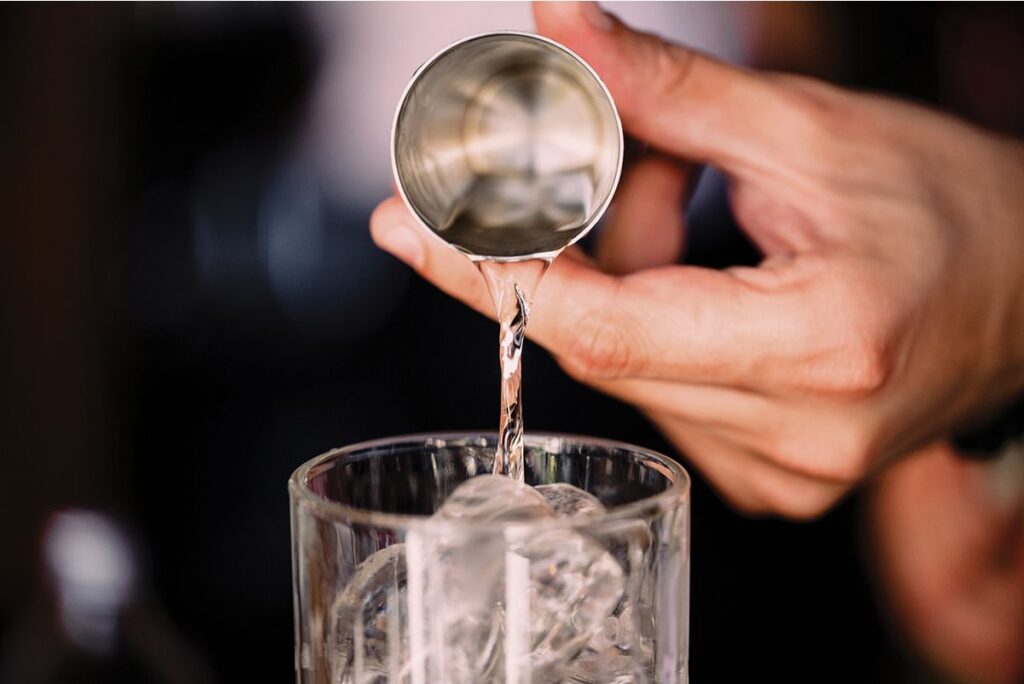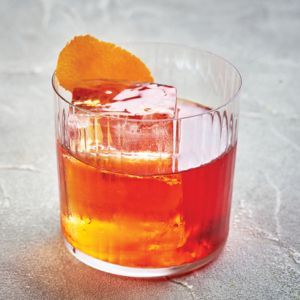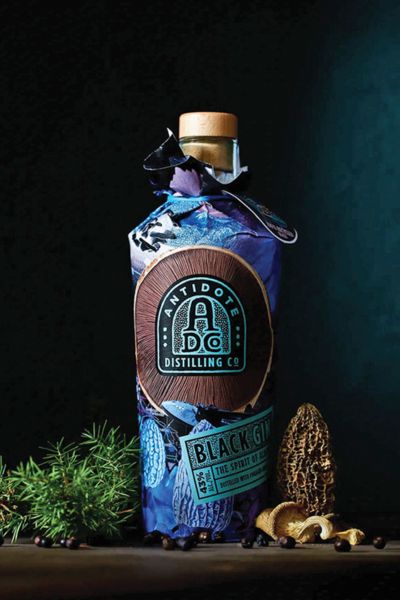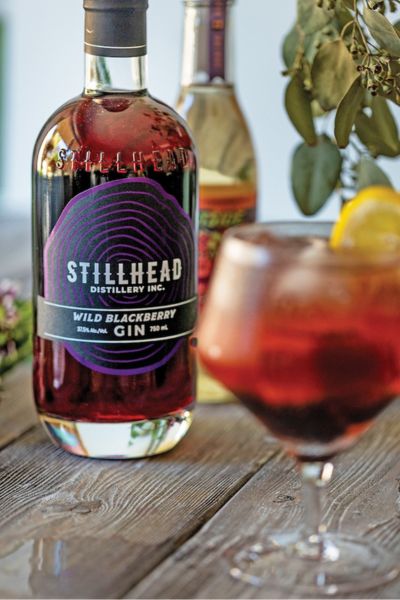Local botanicals are the stars in this refreshing and versatile spirit, perfect for the warm days ahead.
BY JOANNE SASVARI

As the days get longer and brighter and warmer, we crave sips that are light and refreshing rather than rich and comforting. What we crave is gin and the many, many cocktails that can be made with it.
Luckily, here on Vancouver Island we have a bounty of great artisanal gins, many of them made with local botanicals that taste uniquely of this beautiful place.
Gin starts as a neutral spirit, typically (but not always) made from grains such as wheat, rye or, less often, barley. It is then flavoured through maceration, vapour infusion and/or redistillation with a variety of botanicals, as little as four of them in Tanqueray and as many as 47 in the Monkey 47 Dry Gin from Germany, which additionally (and a little exotically) is made from a molasses base.
Those botanicals often include citrus peel, licorice, angelica, orris root and coriander, but what makes gin, gin is the addition of the juniper berries that give it its distinctive piney aroma and bite. That’s because the London Dry style of gin we know today (juniper-forward with a hint of citrus and herbs) evolved from an earlier spirit, genever, a juniper-flavoured grain spirit from the Netherlands that is richer, slightly sweeter and has more of a cereal-grain flavour from malted barley.
Island Botanicals in the Bottle
We think of gin as crisp, fresh and herbaceous, but gins can also be fruity, floral, earthy or savoury, depending on the botanicals.
Just here on Vancouver Island, we can find gins flavoured with local berries, flowers, hops, wild mushrooms, seaweed and/or cedar tips. Most are made with a grain base, but others are made from fermented honey or apples.
Those botanicals, paired with that clean base, make gin one of the most versatile of spirits. It’s refreshing with a generous splash of tonic or soda water and a citrus twist to make the palate pop. It’s elegant in a Martini for those times you really want to savour the botanicals. And it plays nicely in more complex cocktails, such as a bittersweet Negroni, juicy Clover Club or something clever of your own creation.
“Gin has captured the real spirit of the Island.”
Now that the Island’s first craft whiskies finally have enough age on them to be enjoyed, they seem to be getting all the headlines and plenty of prizes, too. But ever since artisanal distilling became a thing in B.C., gin has captured the real spirit of the Island — fittingly, given the English history that flavours the place.
Some of the province’s first distilleries opened here around 2006, followed by a boom in 2013, when the B.C. government modernized its liquor laws. Although some, like the much-lauded DEVINE Distillery, have closed in recent years, there are still around 20 of them on Vancouver and the Gulf Islands. And most, if not all, are making some sort of gin.
So why not pour yourself a little shot, mix it in a cocktail or a highball, and raise a glass to the tasty terroir of the Island? It’s the most refreshing way to welcome the warm weather.
Island Negroni or Sbagliato
The Negroni is one of the great classic cocktails that shouldn’t work, but somehow does. Traditionally, it’s made with equal parts gin, Campari and sweet vermouth, though we also like it lengthened with something fizzy, what’s known as a Sbagliato.
- 1 oz Vancouver Island gin
- 1 oz Esquimalt Rosso Sweet Vermouth
- 1 oz Esquimalt Bitter Red
- Garnish: lemon or orange peel
Place all ingredients (except garnish) in a mixing glass with ice and sir until it is chilled and reaches your ideal dilution. Strain it over fresh ice in a rocks glass; garnish with a curtis peel, squeezing some of the essential oils over the drink before dropping it in.
Serves 1.

Make it a Sbagliato: Make the Negroni as above and pour it into a double rocks or large wine glass filled with ice. Top it with about 4 oz soda water or sparkling wine, such as a Cowichan Valley Charme de L’Île. Stir gently, then garnish with the citrus peel.
7 Vancouver Island Gins to Sip Now
These gins use local ingredients to capture the unique flavours of Vancouver Island.

1. Antidote Distilling Black Gin, 43% ABV
The botanicals in this black-hued gin from Port Alberni include juniper and spruce for those classic gin notes, salal berries for their fruity sweetness and an umami-rich blend of Island truffles and locally foraged mushrooms. Plus it turns a bright violet when you add tonic water. Complex, layered, utterly unique.
2. Merridale Cowichan Gin,
40% ABV
Perhaps not surprisingly for a distillery that’s also a cidery, the base of this handcrafted gin is entirely made from B.C. apples. It is then flavoured with Cowichan Valley botanicals ranging from coniferous trees to local berries and even the herbs and roots used for ground cover. This gin is all about the terroir.
3. Sheringham Seaside Gin and Beacon (Kazuki) Gin, both 43% ABV
We couldn’t decide between these two exceptional gins from formerly Sooke-based Sheringham, which has relocated to Langford, so we included both. Seaside is their flagship gin, the one that’s won all the awards and has wonderfully briny notes from sustainably harvested winged kelp. Beacon Gin, formerly known as Kazuki Gin, is a fragrant bouquet of floral and fruity notes from cherry blossoms. Both capture essential flavours of the South Island.
4. Stillhead Wild Blackberry Gin, 37.5% ABV
This award-winning gin from Duncan pays homage to the sloe gins so popular in the U.K. A classic gin base is made smooth and fruity with locally harvested wild blackberries and Canadian honey. Delicious lengthened with soda.
5. Tofino Distillery Old Growth Cedar Gin, 45% ABV
This award-winning, small-batch, organic gin includes a healthy amount of western red cedar tips in its botanical mix. Its aroma is like a coastal forest after the rain, complete with Tofino fog when ice is added (thanks to its non-chill-filtered process). The spirit of the rainforest in a glass.
6. Wayward Distillery Unruly Gin, 43% ABV
Up in Courtenay, David Brimacombe and his crew are fermenting honey into mead, then distilling that mead into an elegant and subtle gin flavoured with local and organic botanicals. Among them: cedar, lavender, sarsaparilla root and coriander. A smooth and versatile Canadian-style alternative gin.

Dirty Island Martini
If you love the savoury flavour of a classic Dirty Martini, but wish it could be even brinier, then this is the drink for you. Instead of olives, it uses the brine from quick-pickled garlic scapes, kicked up a notch with the salinity of seaweed in the Sheringham Seaside Gin. Of course, if you are too impatient to make your own pickled scapes, you can use green olives and their brine instead.
- 2 oz gin, preferably Sheringham Seaside Gin
- ½ oz Esquimalt Dry Vermouth
- ½ oz brine from pickled garlic scapes (see recipe below) or green olives
- Garnish: 1 pickled garlic scape or 3 green olives
Place all ingredients (except garnish) in a cocktail shaker with ice and shake well. Fine-strain into a chilled cocktail glass. Garnish with the pickled scape twisted around the inside of the glass or three olives on a skewer. Serves 1.
Quick-Pickled Garlic Scapes
Garlic scapes — the curly green stalks of hardneck garlic plants — start appearing in farmers’ markets in June, and are delightful in pesto, grilled as a side dish or pickled, as they are here, and used in cocktails or on burgers and other sandwiches. Note that this is a quick pickle; it should be kept in the refrigerator and consumed within three months. Makes two 1L jars.
- 1 tsp peppercorns, divided
- 1 tsp mustard seeds, divided (Optional: ½ tsp red pepper flakes, divided)
- 1 large bunch garlic scapes, about ½ lb
- 2 cups apple cider vinegar
- 2 cups water
- 2 Tbsp kosher salt
- 1 Tbsp sugar
Thoroughly clean two litre-sized mason jars and their lids and allow to air dry; to be absolutely sure of avoiding contamination, place them in boiling water for 10 minutes.
When they are dry and cool enough to handle, divide the peppercorns, mustard seeds and red pepper flakes (if using) between the two jars.
Trim the garlic scapes by removing any withered ends, then cut them into lengths that will fit into your mason jars. Arrange scapes in the jars, winding them around the sides if you like, leaving about ½-inch headspace at the top.
Combine apple cider vinegar, water, salt and sugar in a medium-sided pot. Bring to a boil and stir until salt and sugar dissolve.
Pour the brine into the jars, making sure the garlic scapes are completely covered with the liquid. You should have about ¼ to ½ inch of headspace.
Loosely fit the lids onto the jars and leave
on the counter until they cool to room temperature. Tighten lids and place in the refrigerator to pickle for at least 48 hours before using. (They should be at their peak after about two weeks.) Consume or discard within three months.




